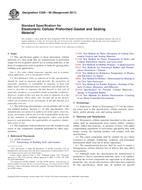Potřebujeme váš souhlas k využití jednotlivých dat, aby se vám mimo jiné mohly ukazovat informace týkající se vašich zájmů. Souhlas udělíte kliknutím na tlačítko „OK“.
ASTM C509-06(2011)
Standard Specification for Elastomeric Cellular Preformed Gasket and Sealing Material
Automaticky přeložený název:
Standardní specifikace pro Kaučukovitý Cellular předem připraveného těsnění a těsnící materiál
NORMA vydána dne 1.6.2011
Informace o normě:
Označení normy: ASTM C509-06(2011)
Poznámka: NEPLATNÁ
Datum vydání normy: 1.6.2011
Kód zboží: NS-13817
Počet stran: 5
Přibližná hmotnost: 15 g (0.03 liber)
Země: Americká technická norma
Kategorie: Technické normy ASTM
Anotace textu normy ASTM C509-06(2011) :
Keywords:
cellular, compression, elastomer, elastomeric, gasket, glazing, preformed, seal, sealing, Cellular materials, Compression seals--specifications, Elastomeric seals/sealants--specifications, Gaskets--specifications, Glazing compounds/applications--specifications, Preformed sealant tapes--specifications, Sealants--specifications, ICS Number Code 83.140.50 (Seals)
Doplňující informace
| Significance and Use | ||||||||||||||||||||
|
Flame Propagation: This specification has two options: Option I—Flame propagation test is required. Option II—Flame propagation test is not required. In case no option is specified, Option I will apply. This specification has two classifications as related to ozone resistance. These are Type I and Type II, with the latter having the greater resistance to ozone. The type should be specified when making reference to this specification but in the event that the type is not specified, Type II shall apply. Note 2—Type II is included in this specification for use where greater ozone resistance is required. |
||||||||||||||||||||
| 1. Scope | ||||||||||||||||||||
| DESIG
1.1 This specification applies to those elastomeric cellular materials of a firm grade that are manufactured in preformed shapes for use as gaskets and for use as sealing materials, in the form of compression seals or gaskets, or both, for glazing other building joint applications. Note 1—For softer cellular elastomeric materials used in secondary sealing applications, refer to Specification D1056. 1.2 Test Method C1166, as referenced in this specification, should be used to measure and describe the properties of materials, products, or assemblies in response to heat and flame under controlled laboratory conditions and should not be used to describe or appraise the fire hazard or fire risk of materials, products, or assemblies under actual fire conditions. However, results of this test may be used as elements of a fire risk assessment which takes into account all of the factors which are pertinent to an assessment of the fire hazard of a particular end use. 1.3 The following precautionary caveat pertains only to the test method portion, Section 11, of this specification: This standard does not purport to address all of the safety concerns, if any, associated with its use. It is the responsibility of the user of this standard to establish appropriate safety and health practices and determine the applicability of regulatory limitations prior to use. 1.4 The committee with jurisdiction over this standard is not aware of any comparable standards published by other organizations. X1.1.1 This test method is intended to determine the ability of compounds made from rubber or rubber-like materials to resist the effect of low temperatures that may cause them to become brittle and fracture or crack when bent. Standard specimens are exposed to specified low temperatures for definite periods after which the specimens are bent in a prescribed manner and any fracture or cracking noted. The procedure is commonly called the “Thiokol” method. Note X1.1—Results obtained by this test method are influenced by the rate of flexing of the cooled specimens which can not be closely controlled in the prescribed apparatus. They are therefore of a qualitative nature and may not be closely reproducible over a range of several degrees of temperature depending on the speed of flexure. For more accurate determination of brittle temperature, and particularly in new specifications, Test Method D746 is recommended. |
||||||||||||||||||||
| 2. Referenced Documents | ||||||||||||||||||||
|




 Cookies
Cookies
